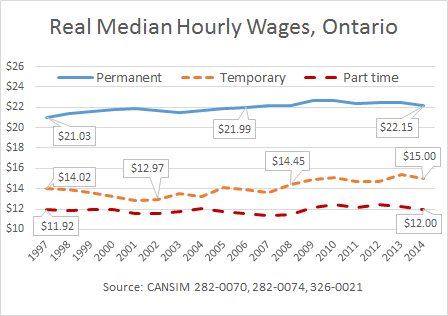Transforming Precarious Work
The Ontario government has launched a review of their Labour Relations Act and Employment Standards Act. The premise is that the workplace has changed, and Ontario labour law no longer does as much as  it should to protect vulnerable workers.
The Workers’ Action Centre in Toronto took this opportunity to document the myriad ways that workers are left behind, and make 47 concrete recommendations to improve legislative protections.
What’s unique about this report is that worker’s voices are central. Throughout the report links are made between the lived experiences of workers, current labour market statistics, and thoughtful recommendations to make workers’ lives better.
One huge problem in precarious work is the downloading of risk to workers. This is done through just-in-time scheduling, overuse of part-time and temporary employment relationships, and employee misclassification. Too many “workers” are classified as self-employed, and this practice has spread into a surprising number of sectors.
A 2010 review of the construction sector in Ontario found that misclassified independent contractors cost the province $1.4B to $2.4B in WSIB, income tax, CPP, and EI payments. This doesn’t even begin to touch on the lost wages and benefits to workers. The Workers’ Action Centre report offers suggestions that put the legal onus on an employer to prove there is no employee / employer relationship, which could help stem this trend in precarious work.
Another key issue highlighted by the report is “Equal Pay for Equal Work”. One might be forgiven for thinking that this has to do with the gender wage gap (well, it’s related, as we’ll see). Workers in temporary and part-time positions earn far less money than their permanent full-time counterparts. Workers in temporary positions tend to be young workers, women, and racialized workers (which is a factor in the gender and racialized worker wage gap).
This answers the question of why we care about part-time work when the vast majority of workers ‘choose’ to work part-time. It’s because part-time and temporary workers are overwhelmingly low wage, and along with that tend to have much weaker bargaining power in all aspects of their employment.
I absolutely encourage anyone who is putting together their own organization’s response to read this report, and to support the recommendations found within. Precarious workers are counting on us to make sure the Employment Standards Act recognizes their lived reality. This is not only a show of basic solidarity, but the base upon which all worker’s protections stand.


We might also consider the effect on precarious work of a federal Job Guarantee:
The Social Enterprise Sector Model for a Job Guarantee
http://neweconomicperspectives.org/2014/01/social-enterprise-sector-model-job-guarantee-u-s.html
Imagine 25 million people with no income or precarious forms of income. Now imagine 25 million with a decent base wage. The effect on the private for-profit sector would surely be more stable demand, ringing cash registers, increasing profits, growth and, yes, a lot more better-paying private sector jobs.
I’m extremely happy to hear you are participating in this review. I had to work in “precarious” jobs for a few years. I knew that the low wages would be difficult, but I was prepared for that. What I didn’t anticipate was the complete devastation to my life that just-in-time scheduling would have. I got my weekly schedule just 2 days before the start of the schedule. I was unable to plan anything, even doctors appointments. If I booked the time off in advance, it was simply taken away from my hours so that week I would have less than usual. I went to see my MPP about it but he said it was the first he had heard of the problem, and while he sympathized he didn’t think there was anything he could do to look for changes to be made.
Thank you for your continued support of workers.